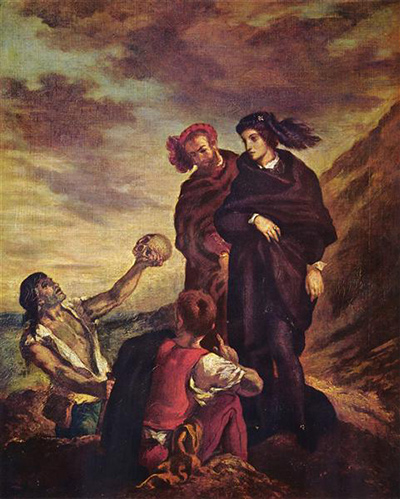Shakespeare was wildly popular in the Romantic period, influencing French creative artists such as composer Berlioz and writer Victor Hugo, as well as the painter Delacroix.
In Hamlet and Horatio in the Cemetery Delacroix shows one of Shakespeare's most macabre and well known scenes. Hamlet sees the skull of the jester, Yorick, dug up in the graveyard, and meditates on mortality and the fragility of life.
Delacroix had seen Hamlet in Paris and was fascinated by the moody, enigmatic prince. He made a series of lithographs and paintings of scenes from the play, and even painted a self-portrait in the role of Hamlet.
(It's interesting that Delacroix might never have seen this scene acted; though it's a key component of the play, its mixture of comedy and tragedy did not fit the French stage conventions, so it was not shown in Paris. That may be why Delacroix doesn't show Hamlet holding the skull, which was already the conventional imagery of the English stage and illustrations of the text.)
The gloomy setting, with louring clouds hiding the blue of the sky, and Hamlet's black mourning suit, create a melancholy atmosphere.
The gravedigger, half his body hidden in the hole that he is digging, seems to thrust the skull at Hamlet.
The line of his arm, and his line of vision, connect with Hamlet's face, forming a strong and dramatic diagonal and making Hamlet's eyes the focus of the scene.
Hamlet is a brooding figure. He is in mourning both for his father and for his fiancee Ophelia, who has drowned herself, and whose grave is now being dug; but he is also contemplating his revenge on his wicked uncle.
Delacroix' handling of the subject shows that melancholy intensity; Hamlet's eyes almost seem to be burning. Yet he is a rather passive figure, seeming to withdraw, pulling his hand away, compared with the active, bearded figure of Horatio.
This picture is undeniably melodramatic, but Delacroix manages to capture a sense of mournful intensity, a very romantic and indeed Romantic view of Hamlet.




